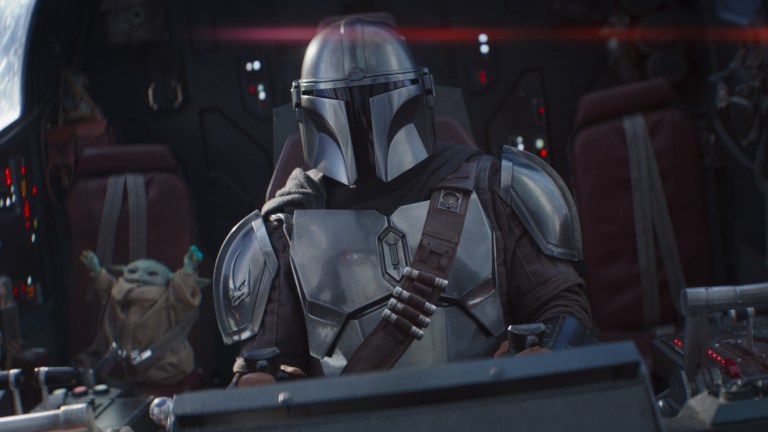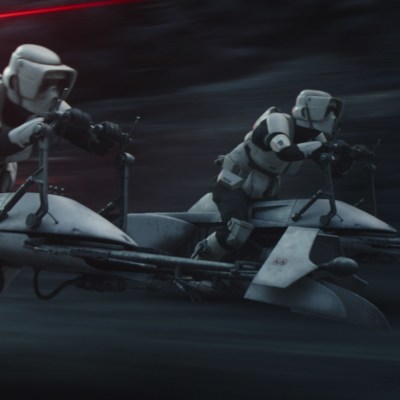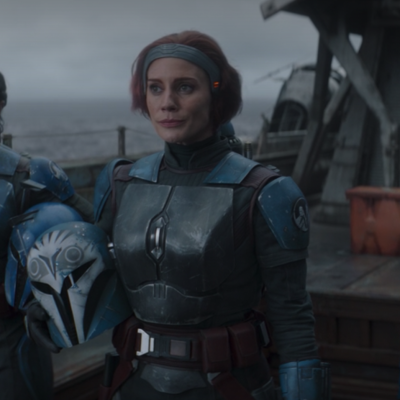The Mandalorian: How Carl Weathers’ Star Wars Directorial Debut Brilliantly Evokes A New Hope
Carl Weathers' Star Wars directorial debut on The Mandalorian shows that he really gets what made A New Hope so great back in 1977.

This Star Wars: The Mandalorian article contains spoilers.
In many ways, The Mandalorian episode “The Siege” is a love letter to George Lucas’ original Star Wars movie: the episode draws heavily from classic scenes from the original film for its own action sequences and set dressing. The combat in particular nods at scenes straight out of the Original Trilogy.
“The Siege” marks the Star Wars directorial debut of actor Carl Weathers, who also plays Greef Karga on the show. Weathers’ first attempt at capturing what made Star Wars so great in 1977 is largely successful, an energetic episode full blaster fire, last-second escapes, and a chase sequence that will make you feel like you’re right back in the Battle of Yavin. Most importantly, Weathers deftly shows his love and knowledge of Star Wars, both in front and behind the camera.
Homage and references to classic movies are key to the Star Wars DNA. Lucas used World War II movies as direct templates when crafting the space battles of what would become A New Hope. Similarly, Weathers uses A New Hope as a template, giving us moments that feel both wonderfully nostalgic and new to The Mandalorian at the same time.
Stream your Star Wars favorites right here!
Here are the big scenes in which Weathers paid tribute to A New Hope in “The Siege.”
Cara Dune Takes Down the Aqualish
As many scenes in The Mandalorian do, the introduction to Cara Dune in the episode shares some traits with the famous Mos Eisley cantina. The aliens Cara defeats are Aqualish, the same species as Ponda Baba, one of the two criminals who menaced Luke Skywalker in the cantina in A New Hope. Their wide eyes and fleshy mouths nod at the traditional “gray” aliens associated with UFO sightings. The dingy setting has that Original Trilogy Outer Rim look, too.
Weathers’ opening fight scene goes its own way after establishing the easter eggs and references, though. Cara is a different kind of fighter than Obi-Wan, and the result is far more chaotic and violent hand-to-hand struggle than the Jedi Master’s quick flick of the wrist with his lightsaber. It’s a very exciting way to open the episode.
Imperial Hallways and Tractor Beam
The Imperial science facility Mando, Cara, Greef, and the unlucky Mythrol infiltrate is a nod to classic Imperial architecture, evoking the very first enemy base fans ever saw: the Death Star. The sneaking sequences aren’t exactly the same (since The Mandalorian‘s main trio mostly prefer blasting their way through stormtroopers) but watching them explore those angular hallways reminds us of Luke, Han, and Obi-Wan’s rescue mission in the classic adventure. At one point, Mando’s group stops and waits for stormtroopers to pass, just like Obi-Wan does as he looks for the tractor beam controls.
The key part of Mando, Greef, and Cara’s plan also mirrors the tense scene in which Obi-Wan lowers the tractor beam in A New Hope, as the the Mythrol inches around, slowly shuffling across a railless catwalk, to the overload panel to destroy the base. Both times, the camera focuses in on the graphics of the panel to provide some extra sci-fi detail, including the Aurebesh lettering.
Trench Run and Death Star Escape
Greef, Cara, and the Mythrol’s escape from the Imperial base in their relatively ungainly hover vehicle shares a few similarities with A New Hope‘s classic space sequences. The first is the way the heroes zoom through a canyon, TIE fighters giving chase and firing down at them. Cara zigzags and performs evasive maneuvers just as Rebel X-wings did during the Death Star trench run at the end of the movie. From here, two different sequences mingle.
The very entertaining chase sequence treats us to both shots from the ground as well as inside the enemy cockpits, including one of a TIE pilot adjusting an instrument. In the movie, it’s Vader who does the adjusting while tailing the Rebels over Yavin.
Greef also takes on Luke Skywalker’s role as the inexperienced gunner, shooting down enemies as they appear on his targeting computer, a scenario that immediately brings to mind the original heroes’ daring escape from the Death Star. Meanwhile, Cara and the Mythrol provide reactions just like Leia and Chewie in the original.
The chase sequence alternates between all of these shots to great effect, and is easily one of the best action setpieces featured on the live-action series so far. As the scene goes on, a TIE fighter pilot locks on in a nearly identical shot to one from the Death Star trench run when Darth Vader locks on to a Rebel ship.
Rebel Rescue
All hope seems lost as the TIE fighters gain on the much slower ground transport. But just as the Imperial is preparing to fire on our heroes, Mando shows up with the Razor Crest to save the day. It’s a surprise rescue that definitely nods at the Falcon, which makes a last second save that clears the way for Luke to fire at the Death Star’s thermal exhaust post.
Mando is the Han Solo in this scenario, swooping in just as Vader is about to put an end to Luke. His rescue isn’t as emotionally fraught as Han’s — no one thought he was abandoning the gang for good. And it’s longer, leading to that incredible vertical battle between the Razor Crest and two TIEs. But the sense of relief and the reaction shots convey that same exultant feeling.
Alderaan
The script by showrunner Jon Favreau neatly reminds the viewer of Cara Dune’s backstory near the end. Rebel patrol pilot Carson Teva reminds her of how the Empire destroyed the planet Alderaan — a personal blow, since it’s Cara’s home planet. She lost everyone she loved there, which is why Teva believes she should get justice by stamping out the Empire on behalf of the New Republic.
It’s an important character moment for Cara, who now has to decide whether she wants to remain a backwater marshal or become an operative for the galactic government. It also ties the episode even closer to the first Star Wars installment since the destruction of the planet was one of the first atrocities the Empire committed in the saga.
The Classic Star Destroyer Opening Shot
The introduction of Moff Gideon’s Imperial starship at the end of the episode is injected with extra menace thanks to a shot pulled right out of Lucas’ playbook, which makes the ship look truly massive as it covers the entire screen. This is of course a VFX trick first deployed in A New Hope‘s famous opening shot. The unnamed Arquitens-class command cruiser glides across the screen just like Darth Vader’s Star Destroyer on its way to capture Princess Leia.
It’s possible some choices weren’t intended as direct homages. They may simply be the best way to show dogfight action, as they were when those World War II shots captured Lucas’ imagination. The Mandalorian continues to be a love letter to Star Wars, and, as we’ve seen with Bryce Dallas Howard, being able to make something that looks like what came before is part of the deal of telling stories in this universe. Weathers certainly proved he can do that in his directorial debut. And fans looking for classic Star Wars action will definitely find it in “The Siege.”



